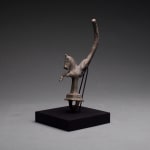Bronze Fragment Depicting Pegasus, 300 BCE - 100 CE
Bronze
17.1 x 3.5 cm
6 3/4 x 1 3/8 in
6 3/4 x 1 3/8 in
FZ.390
Further images
Pegasus, famed winged horse of Greek mythology, sprang forth from Medusa's neck when she was killed by the hero Perseus. Shortly after its birth, the magic steed struck the ground...
Pegasus, famed winged horse of Greek mythology, sprang forth from Medusa's neck when she was killed by the hero Perseus. Shortly after its birth, the magic steed struck the ground on Mount Helicon, and on the spot a spring, later sacred to the Muses and believed to be a source for poetic inspiration, began to flow. All longed in vain to catch and tame the creature, and this became the obsession of Bellerophon, prince of Corinth, who captured the horse with the aid of Athena. Pegasus thereafter proved to be a great help, aiding the hero in his adventures against the Amazons. However, Bellerophon was overcome by his own pride. When he attempted to fly to the top of Olympus to join the gods, the wise horse threw him, leaving Bellerophon to wander disconsolately about, hated by the gods. Pegasus found shelter in the Olympian stalls and was entrusted by Zeus with bringing him his lightning and thunderbolts.
This bronze decorative fragment depicts the mythological stallion in flight, wings open, legs prancing forward. The details of the horse are outstanding, from the incised eyes and mouth to the finely detailed hair and mane. The base stand has also been decorated by a pattern of diagonal hashes, imitating foliage. The base terminates in a loop, presumably used to hang something. However, what this extraordinary work of sculpture was once attached to remains a mystery. The artistry of this fragment is evident. Clearly this was treasured in antiquity as it is treasures today.
This bronze decorative fragment depicts the mythological stallion in flight, wings open, legs prancing forward. The details of the horse are outstanding, from the incised eyes and mouth to the finely detailed hair and mane. The base stand has also been decorated by a pattern of diagonal hashes, imitating foliage. The base terminates in a loop, presumably used to hang something. However, what this extraordinary work of sculpture was once attached to remains a mystery. The artistry of this fragment is evident. Clearly this was treasured in antiquity as it is treasures today.







